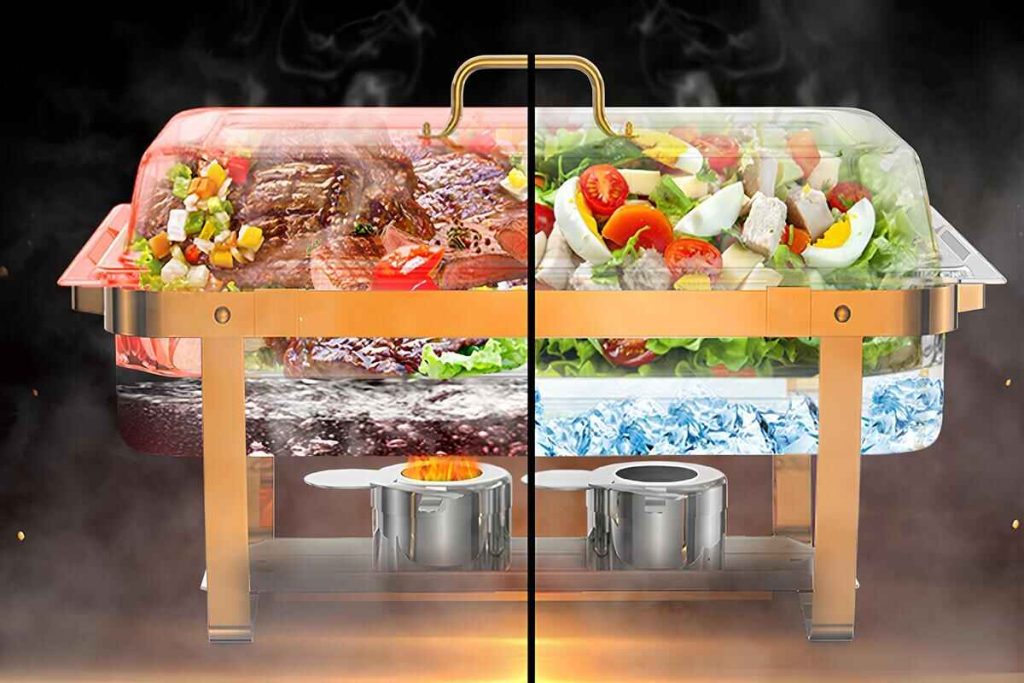A chafing dish is one of the most dependable and elegant tools for keeping food warm during buffets, parties, or catered events. Whether it is a hotel breakfast or a wedding banquet, this simple yet effective device maintains food at the perfect serving temperature for hours without drying or overcooking it. It provides consistent warmth that enhances both presentation and taste, ensuring that every guest enjoys their meal at its best.
At its core, a chafing dish combines basic physics with thoughtful design. It uses indirect heat to gently warm food, preventing direct contact with flames or harsh heating elements. This system allows chefs and event organizers to keep dishes fresh and appetizing even during long service hours. It represents the perfect balance between practicality, safety, and style in food presentation.
Basic Principle behind a Chafing Dish
A chafing dish operates on the principle of indirect heating, using steam as the main medium of heat transfer. The process begins when the heat source beneath the water pan generates warmth. This heat warms the water, creating steam that gently surrounds the food pan placed above it. The food stays warm because the steam maintains a constant temperature without burning or scorching the food.
The key advantage of this method is its consistency. The water acts as a natural buffer that absorbs and releases heat gradually, preventing sudden temperature changes. This indirect process ensures steady and even warmth for hours, making the chafing dish a reliable choice for any event where food must remain fresh and safe for extended periods.
Components That Make the System Work
A chafing dish consists of several essential parts, each serving a unique purpose in heat regulation and presentation:
- Frame: The frame provides structural support for the entire unit, holding the food pan, water pan, and heat source securely in place.
- Water Pan: This lower pan holds hot water, which acts as a medium to generate steam that transfers heat evenly to the food pan.
- Food Pan: Positioned above the water pan, this section contains the prepared food. It receives gentle, moist heat from the steam below.
- Lid: The lid traps heat and steam inside the dish, preventing temperature loss and keeping the food moist.
- Fuel Holder or Heating Element: Depending on the model, this component holds gel fuel canisters or electric heating elements that provide the heat source.
- Handles and Stand: These ensure safety and portability, allowing the dish to be easily moved without risk of burns or spills.
Each component works together harmoniously to create a stable, efficient heat-retention system that keeps food appetizing for hours.
Types of Heat Sources Used
Different types of heat sources are used in chafing dishes, each suitable for specific settings and requirements.
1. Gel or Wick Fuel Cans
Traditional chafing dishes commonly use gel-based fuel cans that burn steadily for several hours. These fuels, often made from ethanol or methanol, are inexpensive and easy to handle. They are especially useful for catering and outdoor events because they are portable and require no electrical outlet.
2. Electric Heating Elements
Electric chafing dishes are a modern alternative that provide cleaner and more controllable heating. They can be plugged into a power source and adjusted to maintain a consistent temperature. This option is perfect for indoor events where open flames are not allowed or where food needs to stay warm for long durations.
3. Induction and Hybrid Systems
Some contemporary chafing dishes use induction technology, which generates heat directly within the metal pan through electromagnetic energy. This method is efficient, precise, and safer because it eliminates open flames. Hybrid systems may combine induction and electric elements for flexibility and convenience in professional kitchens.
The Science of Heat Retention
The chafing dish works on the principle of thermal equilibrium, which means heat flows from a warmer source to a cooler one until both reach balance. In this case, the heat generated by the fuel or electric element warms the water pan. The water produces steam that envelops the food pan and keeps the contents warm without direct exposure to heat.
Because water has a high heat capacity, it can absorb and store heat energy for long periods before cooling down. This gradual release of heat helps maintain a consistent temperature, ensuring that the food remains warm and safe to eat for hours. The result is steady warmth and an enjoyable dining experience for guests.
Why Even Heating Matters
Even heating is essential in any food service setup. Without it, food can develop cold spots or uneven textures that make it less appealing. Chafing dishes solve this problem by distributing heat through steam, which circulates evenly around the food pan. This consistent warmth keeps every portion of the dish equally heated.
In large buffets or catering services, maintaining even temperature is crucial for both safety and quality. It prevents bacterial growth that can occur when parts of the food cool too quickly. By keeping the temperature balanced, chafing dishes preserve flavor, texture, and safety throughout the serving period. For this reason, many professionals consider a chafing dish the most dependable food warmer available for long-duration events.
Materials and Design That Enhance Efficiency
The materials and construction of a chafing dish play a key role in its performance. Most are made of stainless steel, which is durable, corrosion-resistant, and excellent at retaining heat. Stainless steel also has a smooth, reflective surface that helps distribute heat more evenly across the dish.
Modern chafing dishes may include extra features such as double-walled construction or insulated handles for better heat retention and safer handling. Tight-fitting lids prevent steam from escaping, while water level indicators help users avoid overheating. These thoughtful design elements make chafing dishes both efficient and easy to maintain.
Duration of Heat and How to Extend It
The duration for which a chafing dish can keep food warm depends on its heat source. Gel fuel cans generally last between two and six hours, making them ideal for most events. Electric and induction models can maintain temperature indefinitely, provided they remain connected to power.
However, several strategies can extend its performance:
- Preheat the Water Pan: Using hot water instead of cold reduces the initial warm-up time and conserves fuel or energy.
- Keep the Lid Closed: Every time the lid is lifted, heat escapes. Minimizing lid openings maintains consistent internal temperature.
- Use Wind Guards for Outdoor Events: Shields protect the flame from drafts that can cause uneven heating.
- Replace Fuel on Time: If using gel fuel, monitor burn duration and replace canisters before they extinguish.
- Opt for Electric Models for Long Events: For events lasting over six hours, electric or induction systems provide uninterrupted heat.
Advantages Beyond Temperature Control
Chafing dishes provide benefits that go beyond simply keeping food warm:
- Professional Presentation: Their polished, attractive design enhances the overall look of buffet tables and serving areas.
- Versatility: Suitable for a wide variety of dishes, from soups and sauces to entrees and desserts.
- Portability: Lightweight and easy to transport, making them ideal for outdoor or mobile catering services.
- Cost Efficiency: Reduce the need for constant reheating, saving both time and energy in food service operations.
Safety and Maintenance Tips
To get the best performance and longevity from a chafing dish, follow these safety and maintenance guidelines:
- Use Fuel Safely: Handle fuel cans with care and never refill them while they are still burning or hot.
- Monitor Water Levels: Check and refill the water pan periodically to prevent overheating or dry operation.
- Clean Thoroughly: Wash all components after use with mild soap and warm water to prevent buildup and maintain hygiene.
- Inspect Before Each Use: Make sure that stands, pans, and lids fit properly and are free of dents, cracks, or corrosion.
Proper safety practices not only extend the lifespan of the chafing dish but also ensure smooth operation during service.
The Right Place to Buy
When it comes to purchasing a reliable and high-quality chafing dish, Garvee stands out as a trusted source. The company has built a strong reputation for excellence across multiple industries, offering everything from commercial and automotive equipment to home furniture and toys. This broad expertise reflects a commitment to quality, innovation, and customer satisfaction that few brands can match.
Garvee’s collection of chafing dishes upholds the same high standards found throughout its diverse product range. Each piece is crafted with durability, functionality, and design in mind, ensuring professional-grade performance for both personal and commercial use. Whether you are a caterer, restaurant owner, or home entertainer, it provides dependable chafing solutions that keep food warm and presentation flawless. Choosing Garvee means investing in long-lasting quality and peace of mind.
Final Thoughts
A chafing dish is more than a simple food warmer. It is a carefully engineered tool that combines design, function, and safety to keep meals at their ideal serving temperature for hours. By using indirect heat through steam, it ensures that food remains moist, flavorful, and visually appealing throughout the event.
Whether powered by fuel or electricity, the principle remains the same: gentle and consistent heating that preserves food quality. With proper care, maintenance, and understanding of how it works, a chafing dish becomes an indispensable asset for caterers, hoteliers, and hosts who value both efficiency and presentation.



